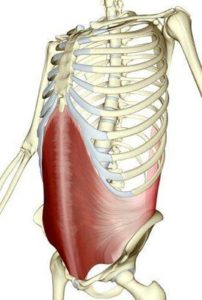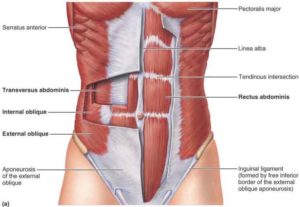Lower Back Pain and The Involvement of the Transverse Abdominals
The Transverse Abdominals (TrA) Muscle
The TrA (aka. Transervaslis, or Transverse Abdominis) is known as the ‘corset’ muscle, as
it wraps around the abdominal region with fibres running in a transverse (horizontal) direction
with respect to the upright trunk. Looking at figure 1., you can see how it acts to enclose the
trunk cavity between the bottom ribs and the top of the pelvis. In the following image (figure
2.) you can visualise how deep the TrA runs to the more superficial muscles and fascia that
make up the rest of the abdominals (figure 2.)
(Fig 1. Image retrieved 1/8/18 from https://www.custompilatesandyoga.com/health/transverse-abdominis-learn-your-muscles/)
(Fig 2. Image retrieved 1/8/18 from http://theworkoutmama.com/tag/transverse-abdominis/)
The importance of TrA activation
In an asymptomatic patient, activation of TrA occurs just before there is movement in any
direction. This works to support the spine before movement occurs, reducing friction and
overstretching of the small joints between each vertebra (Saliba et al, 2010). Interestingly, TrA
activation has been found to be significantly delayed in patients with LBP (Hodges &
Richardson, 1996, and Selkow et al, 2017). This means that the preparatory bracing that
normally occurs before movement is significantly diminished or absent. A study conducted
by Kim et al (2013) utilised ultrasonography to detect the thickness (or bulk) of the TrA in
healthy subjects and subjects with lower back pain (LBP), finding notable muscle atrophy (or
shrinkage) of the TrA in the LBP group.
Evidence also supports the activation of TrA to reduce the joint laxity of the sacroiliac joint
(SIJ), the joint between your pelvis and the base of your spine (Richardson et al, 2002). This joint can cause pain and discomfort when it becomes lax, which can occur in many cases,
but especially in pregnant women due to the release of the hormone relaxin.
How do you improve the strength and activation of TrA?
The TrA muscle can be targeted using specific exercises and techniques that help to
stabilise the pelvis and spine. One such stabilisation method used includes the ‘drawing-in’
of the abdominals. Using this drawing-in technique, Teyhen et al (2005) was able to
demonstrate preferential activation of TrA. These types of stabilisation exercises have been
found to improve LBP and disability scores (Hosseinifar et al, 2013).
Selkow et al (2017) outlines certain exercises that have been shown to improve the onset of
activation of TrA by approximately 1 second before movement is initiated. This pre-activation
helps to train these deep core muscles to provide additional stability to the spine and pelvis
during daily movement, ultimately resulting in reduced pain and disability.These particular
exercises are also highly drawn on and create the basis for clinical pilates.
(Images from Selkow et al, 2017)
Clinical Pilates is based on these principles of correct and effective TrA activation to achieve
a neutral spine, encourage a strong, supportive base for which the limbs to function from,
reducing biomechanical dysfunction related issues and pain, and facilitating smooth and
pain-free movement in your daily life.
If you suffer from back, pelvic or hip pain, spinal instability is likely involved. A thorough
assessment by a trained physiotherapist will help to identify areas of potential dysfunction
and likely involvement of diminished TrA activation. Physiotherapist prescribed exercises
and physiotherapist-run Clinical Pilates can help to greatly alleviate acute and chronic pain
through the strategic and appropriate application of evidence based pilates postures and
exercises.
References
- Hodges, P. W., & Richardson, C. A. (1996). Inefficient muscular stabilization of the lumbar spine associated with low back pain: a motor control evaluation of transversus abdominis. Spine, 21(22), 2640-2650.
- Hosseinifar, M., Akbari, M., Behtash, H., Amiri, M., & Sarrafzadeh, J. (2013). The effects of stabilization and McKenzie exercises on transverse abdominis and multifidus muscle thickness, pain, and disability: a randomized controlled trial in nonspecific chronic low back pain. Journal of physical therapy science, 25(12), 1541-1545.
- Kim, K. H., Cho, S.-H., Goo, B.-O., & Baek, I.-H. (2013). Differences in Transversus
Abdominis Muscle Function between Chronic Low Back Pain Patients and Healthy Subjects at Maximum Expiration: Measurement with Real-time Ultrasonography. Journal of Physical Therapy Science, 25(7), 861–863. http://doi.org/10.1589/jpts.25.86 - O’Sullivan, P. (2005). Diagnosis and classification of chronic low back pain disorders:
maladaptive movement and motor control impairments as underlying mechanism. Manual therapy, 10(4), 242-255. Richardson, C. A., Snijders, C. J., Hides, J. A., Damen, L., Pas, M. S., & Storm, J. (2002). The relation between the transversus abdominis muscles, sacroiliac joint mechanics, and low back pain. Spine, 27(4), 399-405. - Saliba, S. A., Croy, T., Guthrie, R., Grooms, D., Weltman, A., & Grindstaff, T. L. (2010). Differences in Transverse Abdominis Activation with Stable and Unstable Bridging Exercises in Individuals with Low Back Pain. North American Journal of Sports Physical Therapy : NAJSPT, 5(2), 63–73.
- Selkow, N. M., Eck, M. R., & Rivas, S. (2017). TRANSVERSUS ABDOMINIS ACTIVATION AND TIMING IMPROVES FOLLOWING CORE STABILITY TRAINING: A RANDOMIZED TRIAL. International Journal of Sports Physical Therapy, 12(7), 1048–1056.
- Teyhen, D. S., Miltenberger, C. E., Deiters, H. M., Del Toro, Y. M., Pulliam, J. N., Childs, J. D., … & Flynn, T. W. (2005). The use of ultrasound imaging of the abdominal drawing-in maneuver in subjects with low back pain. Journal of Orthopaedic & Sports Physical Therapy, 35(6), 346-355.






Recent Comments